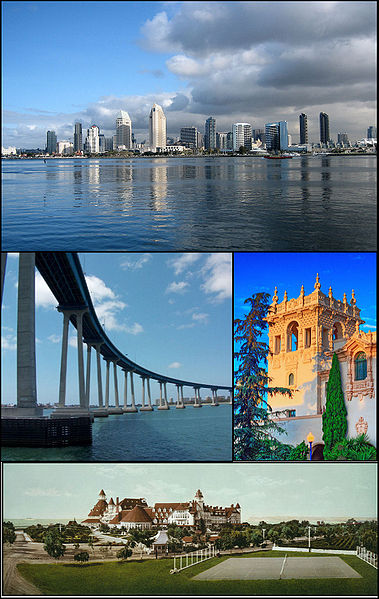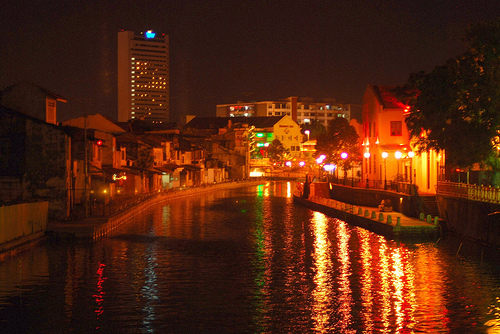San Diego- My Journey Contest Video for Lonely Planet
[media id=29 width=500 height=400]
San Diego is the second-largest city in California and the ninth largest city in the United States, located along the Pacific Ocean on the west coast of the United States. The US Census Bureau estimates the city’s population at 1,279,329 as of 2008. This coastal city is also the county seat of San Diego County as well as the economic center of the San Diego–Carlsbad–San Marcos metropolitan area.
As of 2008, this metropolitan area is the 17th-largest in the United States with a population of 3,001,072 and the 38th-largest metropolitan area in the Americas when including Tijuana, Mexico. According to Forbes the city of San Diego ranks as the fifth wealthiest in the United States. San Diego’s biggest industries are manufacturing, the military, and tourism.
San Diego’s economy is largely composed of agriculture, biotechnology/biosciences, computer sciences, electronics manufacturing, defense-related manufacturing, financial and business services, ship-repair, ship-construction, software development, telecommunications, wireless research, and tourism. The presence of the University of California, San Diego (UCSD) with the affiliated UCSD Medical Center promotes research in biotechnology.
Geography
The city of San Diego itself lies on deep canyons and hills separating its mesas, creating small pockets of natural parkland scattered throughout the city and thus giving it a hilly geography. The same canyons give parts of the city a highly segmented feel, creating literal gaps between otherwise proximal neighborhoods and contributing to a low-density, car-centered built environment.
Downtown San Diego is located on San Diego Bay. Balboa Park lies on a mesa to the northeast. It is surrounded by several dense urban communities and abruptly ends in Hillcrest to the north. The Coronado and Point Loma peninsulas separate San Diego Bay from the ocean. Ocean Beach is on the west side of Point Loma. Mission Beach and Pacific Beach lie between the ocean and Mission Bay, a man-made aquatic park. La Jolla, an affluent community, lies north of Pacific Beach and west of Mira Mesa.
The Cuyamaca Mountains and Laguna Mountains rise to the east of the city, and beyond the mountains are desert areas. Cleveland National Forest is a half-hour drive from downtown San Diego. Numerous farms are found in the valleys northeast and southeast of the city. San Diego County has one of the highest counts of animal and plant species that appear on the endangered species list among counties in the United States.
Ecology
Like most of southern California, the majority of San Diego’s current area was originally occupied by chaparral, a plant community made up mostly of drought-resistant shrubs. The endangered Torrey Pine has the bulk of its population in San Diego in a stretch of protected chaparral along the coast. The steep and varied topography, and proximity to the ocean creates a number of different habitats within the city limits, including tidal marsh and canyons.
The influence of humans has altered existing habitats and has also created habitats that did not exist prior to human development, by construction of buildings, the introduction of new species, and the use of water for lawns and gardens. A number of species of parrots, including the Red-masked Parakeet and Red-crowned Amazon have established feral populations in urban neighborhoods such as Ocean Beach. The chaparral and coastal sage scrub habitats in low elevations along the coast are prone to wildfire, and the rates of fire have increased in the 20th century, due primarily to fires starting near the borders of urban and wild areas.
San Diego’s broad city limits encompass a number of large nature preserves, including Torrey Pines State Reserve, Border Field State Park, Mission Trails Regional Park. Torrey Pines State Preserve and a coastal strip continuing to the north is the only location where the rare species of Torrey Pine, P. torreyana torreyana, is found. Due to a combination of the steep topography that prevents or discourages building, and some efforts for preservation, there are also a large number of canyons within the city limits that are nature preserves, including Tecolote Canyon Natural Park, and Marian Bear Memorial Park in the San Clemente Canyon, as well as a number of small parks and preserves.
Downtown urban renewal
Downtown San Diego has experienced some urban renewal since the early 1980s. This has resulted in the opening of Horton Plaza, the revival of the Gaslamp Quarter, and the construction of the San Diego Convention Center. The Centre City Development Corporation (CCDC), San Diego’s downtown redevelopment agency, has been instrumental in change. PETCO Park opened in 2004. The 2005 boom in the construction of condos and skyscrapers brought gentrification as well.
Demographics
As of the census[20] of 2000, there were 1,223,400 people, 450,691 households, and 271,315 families residing in the city. The population density was 3,771.9 people per square mile (1,456.4/km²).
There were 451,126 households out of which 30.2% had children under the age of 18 living with them, 44.6% were married couples living together, 11.4% had a female householder with no husband present, and 39.8% were non-families. 28.0% of all households were made up of individuals and 7.4% had someone living alone who was 65 years of age or older. The average household size was 2.61 and the average family size was 3.30.
In the city the population was spread out with 24.0% under the age of 18, 12.4% from 18 to 24, 34.0% from 25 to 44, 19.1% from 45 to 64, and 10.5% who were 65 years of age or older. The median age was 32 years. For every 100 females there were 101.7 males. For every 100 females age 18 and over, there were 100.4 males.
Race
As of the 2005-2007 American Community Survey conducted by the U.S. Census Bureau, White Americans made up 65.3% of San Diego’s population; of which 48.2% were non-Hispanic whites. Blacks or African Americans made up 6.9% of San Diego’s population; of which 6.7% were non-Hispanic blacks.
American Indians made up 0.6% of the city’s population; of which 0.3% were non-Hispanic. Asian Americans made up 15.0% of the city’s population; of which 14.8% were non-Hispanic. Pacific Islander Americans made up 0.4% of the city’s population; of which 0.3% were non-Hispanic. Individuals from some other race made up 8.3% of the city’s population; of which 0.3% were non-Hispanic. Individuals from two or more races made up 3.5% of the city’s population; of which 2.4% were non-Hispanic. In addition, Hispanics and Latinos made up 27.0% of San Diego’s population.
Culture
Many popular museums, such as the San Diego Museum of Art, the San Diego Natural History Museum, the San Diego Museum of Man, and the Museum of Photographic Arts are located in Balboa Park. The Museum of Contemporary Art San Diego (MCASD) is located in an ocean front building in La Jolla and has a branch located at the Santa Fe Depot downtown. The Columbia district downtown is home to historic ship exhibits belonging to the San Diego Maritime Museum, headlined by the Star of India, as well as the unrelated San Diego Aircraft Carrier Museum featuring the USS Midway aircraft carrier.
San Diego has a growing art scene. “Kettner Nights” at the Art and Design District in Little Italy has art and design exhibitions throughout many retail design stores and galleries on selected Friday nights. “Ray at Night” at North Park host a variety of small scale art galleries on the second Saturday evening of each month. La Jolla and nearby Solana Beach also have a variety of art galleries.
The San Diego Symphony at Symphony Towers performs on a regular basis and is directed by Jahja Ling. The San Diego Opera at Civic Center Plaza, directed by Ian Campbell, was ranked by Opera America as one of the top 10 opera companies in the United States. Old Globe Theatre at Balboa Park produces about 15 plays and musicals annually.
The La Jolla Playhouse at UCSD is directed by Christopher Ashley. Both the Old Globe Theatre and the La Jolla Playhouse have produced the world premieres of plays and musicals that have gone on to win Tony Awards[39] or nominations[40] on Broadway. The Joan B. Kroc Theatre at Kroc Center’s Performing Arts Center is a 600-seat state-of-the-art theatre that hosts music, dance and theatre performances. The San Diego Repertory Theatre at the Lyceum Theatres in Horton Plaza produces a variety of plays and musicals. Other professional theatrical production companies include the Lyric Opera San Diego and the Starlight Theatre.
Tourism has affected the city’s culture, as San Diego houses many tourist attractions, such as SeaWorld San Diego, Belmont amusement park, San Diego Zoo, and the nearby San Diego Wild Animal Park and Legoland California. San Diego’s Spanish influence can be seen in the many historic sites across the city, such as the Spanish missions and Balboa Park. Cuisine in San Diego is diverse, and includes European-American, Mexican-American, and Asian-American cuisine. Annual events in San Diego include Comic-Con, San Diego/Del Mar Fair, and Street Scene Music Festival.
Public transportation
San Diego is served by the trolley, bus, Coaster, and Amtrak. The trolley (system map) primarily serves downtown and surrounding urban communities, Mission Valley, east county, and coastal south bay. A planned Mid-Coast line will operate from Old Town to University City along the 5 Freeway. There are also plans for a Silver Line to expand trolley service downtown.
The Amtrak and Coaster trains currently run along the coastline and connect San Diego with Los Angeles, Orange County, Riverside, San Bernardino, and Ventura via Metrolink. There are two Amtrak stations in San Diego, in Old Town, and Downtown (downtown).
The bus is available along almost all major routes; however, a large number of bus stops are concentrated in central San Diego. Typical wait times vary from 15 to 30 minutes, depending on the location and route. Trolleys arrive at each station every 7 to 30 minutes (depending on time of day and which trolley line is used). Ferries are also available every half hour crossing San Diego Bay to Coronado.
San Diego, San Diego photo, San Diego video, San Diego culture, San Diego galleries, San Diego information, San Diego facilities, San Diego conceirge services, San Diego cafe, San Diego hotel, San Diego hostel, San Diego room categories, San Diego shopping complex, San Diego market, San Diego night market, San Diego beach, San Diego island, travel, travelling, hotel, hostel, beach, island, resort, tourism, holiday, destination, guide, travel video, travel video clip, undersea world, diving, casino, crafts, surf, cultural, culture, market, night market, history museum, nomad, districts, festival, archery, adventure, travel, flying fox, scuba, diving, ruins, hiking, rafting, reef, Destination guide, adventure nature, backpacker, Lonely Planet travel video, my journey, contest, t-mobile, myTouch, san diego
























